The Baptism of Jesus
by Jeffrey J. Harrison
There are few places on earth as dramatic as the spot where Jesus was baptized by John. From Jerusalem, the road drops down steeply among desert hills and cliffs to almost 1,000 feet below sea level. Here, at the lowest point above water on the surface of the earth, there is a flat, 10-12 mile wide desert area flanked on the east and the west by a wall of huge, rocky cliffs and steep slopes. Right in the middle of this desert (called the Aravah in Biblical Hebrew) is a much smaller canyon with a river inside it: the Jordan River. Aside from the few meters of green on either side of the river, the land is barren and dry—a tan-colored rocky soil with a few small desert plants here and there.
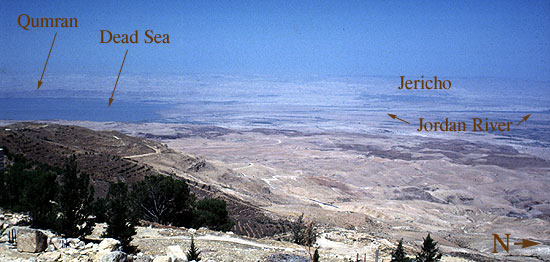
The first reaction of most people to the Jordan River is disappointment. It is neither deep nor wide as they expect it to be. If it was any smaller, you could jump across it. In part, this is due to all the water that’s pumped out today for agriculture. But even in Jesus’ day, in the dry time of year, the amount of water dropped off dramatically. John had to hunt for stretches of the river where there was enough water to baptize (John 3:23).
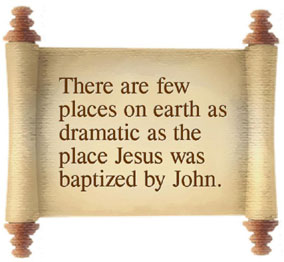
This barren desert location may seem an odd place from which to address the nation. But John was here in fulfillment of the prophecy A voice is crying out in the desert, prepare the way of the Lord
(Isa. 40:3, also Matt. 3:3 and John 1:23). If he had wanted to, he could have gone much further into the desert. But the Jordan lay near the major pilgrim route to Jerusalem from the east. Anything happening along its length would soon be made known in Jerusalem, and from there to the rest of the nation. John wanted his message to be heard.*
* Until recently, the historical baptism site of Jesus was off limits in a military zone near Israel’s border with Jordan. The only way to see a nearby stretch of the river was to cross between Israel and Jordan at the Allenby Bridge border crossing. But today, accessible tourist sites have been developed on both sides of the river (Al-Maghtas on the Jordanian side, and Qasr el-Yahud on the Israeli side). The church pictured above is the Orthodox Church of John the Baptist on the Al-Maghtas side.
A voice from the desert carried with it moral authority. Israel’s formative experiences with God were in the desert: the revelation at Mt. Sinai, the provision of manna, the pillar of fire and cloud. Great miracles had taken place within sight of the place John was baptizing: the destruction of Sodom and Gomorrah, the toppling of the walls of Jericho, the ascension of Elijah to heaven. By contrast, the wetter side of Israel, nearer the Mediterranean Sea on the west, was the place of temptation and compromise with false gods, the route of foreign armies that had conquered and oppressed the people.
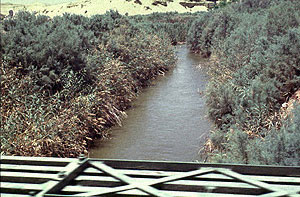
This gave the desert a sense of purity, of being closer to God. In the time of Jesus and John, this attracted many: hermits and small communities renounced the ease of life in the greener areas of the country and came to the desert to live. One of these groups was the Dead Sea Community at Qumran. Members of this group gave up all their earthly belongings, and even marriage, in order to live a strict life of work and worship in the desert.*
* The famous Dead Sea Scrolls were the community’s library. The discovery of a few women in the community’s graveyard has now been to shown to date from a later time period, and so is not connected with the Dead Sea Community.
Why did they feel the need to make such an extreme change in their lifestyle? The writings of the community reveal that its members were convinced the Messianic age was about to dawn. Their withdrawal to the desert was to prepare themselves for the coming of that age, and the part they believed their community would play in its arrival.
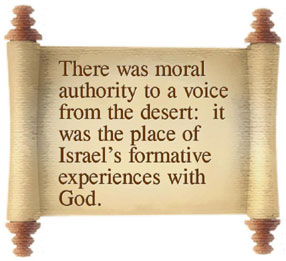
They, together with many others among the Jewish people, saw evidence of the coming of the Messiah in the difficult times they were going through. The source of most of these difficulties was their loss of independence to the Romans about sixty years before the birth of Jesus. The Romans were unclean, idol worshippers, and oppressed the people with heavy taxes. They had replaced the rule of God over the nation with the rule of Caesar. But the problem wasn’t only the Romans: many of the Jewish people themselves were attracted by Roman power and wealth and had become collaborators with the enemy.
The attraction of the West wasn’t a new problem. Hellenization* among the religious leaders had sparked a nationalistic uprising that overthrew Greek power and established an independent Jewish nation. This was the Maccabean Revolt—a hundred years before the Romans arrived (175 BC)—that gave rise to the festival of Hanukkah. But within a few years, Hellenisim had gained the upper hand again, this time pitting the Hellenized supporters of the Sadducees in a civil war against the more conservative Pharisees. This war gave the Romans an excuse to invade and establish the Sadducees in a position of power (63 BC).
* The influence of Greek ideas, values, and cultural practices. If it were happening today, we would call it secularization.
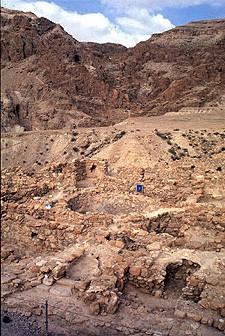
For many, the Sadducees and their supporters, who controlled the priesthood and the Temple, had become enemies of God. The Dead Sea Community was so offended by them, they no longer brought sacrifices to the Temple. The Pharisees denied those who agreed with their teachings a place in the world to come.
John the Baptist and others in the desert, including Jesus, sided with this conservative nationalist-religious
camp against the Sadducees.* Jesus overturned the tables in the Sadducean-controlled Temple and prophesied its destruction.** His parable about the farmers in the vineyard and his cursing of the fig tree expressed his strong rejection of the Temple’s Sadducean leadership (Luke 20:9-19; Mark 11:12-21).
* There are many parallels between the cultural conflict among the Jews in Jesus’ day and the modern secular-religious divide in Israel. Although Jesus rebuked the conservative Pharisees for hypocrisy (Matt. 23), he shared with them their primary theological positions, and opposed the opinions of the Sadducees.
** These prophecies were fulfilled to the letter forty years later when the Romans destroyed the Temple (in 70 AD).
John the Baptist’s message cut to the core of the problem. Even though the Jewish people are set apart for God, being a descendant of Abraham is not enough to ensure a right relationship with God (Matt. 3:9). Something more is needed: a personal repentance, and a life that lives out that repentance (Matt. 3:6,8,11). This message, delivered by John to the Jewish people, applies just as well to Gentile Christians today who consider themselves God’s chosen people. A right relationship with God comes not through membership in the right church, but through personal repentance. Nor can you rely on past experiences if there is no fruit in your life. As John made clear, Every tree that does not bear good fruit is cut down and thrown into the fire
(Matt. 3:10).*
* This is why a large segment of the Protestant movement objects to the baptism of babies: Babies cannot repent of sin, nor can they bring forth the fruit of repentance. The basis of their claim to membership in the body of Messiah is descent: that they have Christian parents. Yes, the Bible does teach that the children of believers are holy (that is, set apart, just like Israel is set apart for God; 1 Cor. 7:14). But as John said, it’s not enough to be a descendant of Abraham to be right with God. As Jesus put it, That which is born of the flesh is flesh, and that which is born of the Spirit is spirit
(John 3:6). We cannot see, let alone enter, the kingdom of God without a spiritual rebirth (John 3:3,5).
But John was not preaching repentance for its own sake. As a prophet, he saw the dawning of the Messianic age on the horizon. His message was a call to prepare for its coming—for all who are not ready will be destroyed by its wrath. The Messiah will gather his wheat into the barn, but he will burn up the chaff with unquenchable fire
(Matt. 3:12).
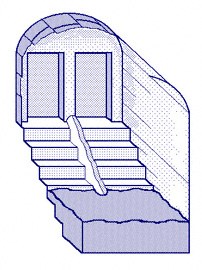
The dawning of this new age called for a dramatic new start in life. This is why John turned to the practice of ritual immersion (baptism). Baptism in water was ordinarily used by the Jewish people for cleansing from different kinds of impurities (Lev. 15). But it was also used as a sign of new life in the conversion of pagans to Judaism.* John, and Christianity after him, expanded this last use of baptism—as a sign of conversion and new life—to represent first readiness for, and later participation in the kingdom of Messiah.
* Conversion to Judaism required a ritual immersion (baptism), the offering of a sacrifice in the Temple and, for men, circumcision. The best water for immersion was living water,
as found in a river or stream—which explains why John was baptizing in the Jordan River (Mikv. 1:1-8). But rock-cut baths fed directly by rain water were also permitted (see diagram).
John’s bold message fell on receptive ears. Thousands came out into the desert to be baptized. But John could only bring the people to a point of readiness. Only the Messiah himself could bring them into the Messianic kingdom. The one coming after me is greater than I...he will baptize you in the Holy Spirit and fire
(Matt. 3:11). This pointed to a much more supernatural Messiah than the rabbis of later centuries were willing to accept, when the Messiah was associated more with this world than the next. But recent evidence confirms the supernatural expectations of the time. A Dead Sea scroll fragment previously known as the Wondrous Child (4Q534) describes the Messiah as being preternaturally wise at a young age, and knowing the secrets of all the living
(col. i).* Another fragment, previously known as A Messianic Vision (4Q521), says The heavens and earth will obey God’s Messiah....he will heal the wounded and resurrect the dead
(frag. 2 & frag. 4, col. ii).
* The subject of this fragment is sometimes identified with Noah. Read it yourself and see what you think. Did Noah know all the secrets of the living
? Did he rule over all things
?
John’s identification of the Messiah with the supernatural power of the Spirit had a firm foundation in prophecy. Isaiah 11:1-5 speaks of the Spirit resting on the Messiah when he comes to judge the earth and destroy the wicked. Isaiah 42 pictures the Spirit leading the Messiah in extending God’s covenant to the nations of the earth: Look, my servant, whom I hold fast; my chosen one, with whom my soul has been pleased. I have set my Spirit on him; he will cause justice to go out to the nations.... The coastlands will wait for his law
(Isa. 42:1). These verses are the Scriptural foundation of the instruction given to John: that he would recognize the Messiah as the one on whom you see the Spirit descending and remaining on him, this is the one who baptizes in the Holy Spirit
(John 1:33).
When Jesus came up out of the waters of baptism, the Spirit descended and rested on him in the form of a dove. This is an allusion to Gen. 1:2, where the Spirit is described as hovering
like a bird over the waters of Creation.* This time, the Spirit hovers over the waters of baptism, joining to an immersion in water the spiritual immersion by which the souls of men are reborn (Matt. 3:11,16; Acts 11:16).
* In the original Hebrew (merakhephet). The rabbis specifically identified this appearance of the Spirit with the Spirit of Messiah in Isa. 11:2, and connected the waters over which the Spirit hovers with repentance: In the same way that a wind always seems to blow over water, the Spirit always seems to move where there is repentance
(Gen. Rab. 2.4). That this interpretation of Gen. 1:2 dates back to the time of Jesus has been proven by the discovery of the Dead Sea scroll fragment mentioned above (A Messianic Vision, 4Q521), which says that the Spirit of the Messiah will hover
over the poor.
The significance of this first Christian baptism was confirmed by a voice from heaven, known to the Jewish people as the bat qol or daughter voice
—the echo of the voice of God (Matt. 3:17).* This introduces the Father God into the picture, which completes the parallel with Genesis 1: Just as the Father, his Word, and his Spirit were present at the Creation, so all three are present at the baptism of Jesus. No wonder this passage was so important to the early Church as a picture of the triunity of God.**
* The words of the Father, by quoting Isa. 42:1, identify Isaiah’s Servant of the Lord (on whom God set his Spirit) with Jesus as God’s Son.
** Jesus’ baptism was celebrated even before his birth became an object of celebration: on January 6th in the 3rd century. Later, this same date was also used to celebrate Jesus’ birth, after which it was moved to December 25th.
The baptism of Jesus was taken as the pattern for baptism by the earliest Church: After repenting and renouncing the devil, new believers were immersed in water. When they came out, hands were laid on them to receive the Holy Spirit (Tertullian, On Baptism, 8; Const. of the Apost., 3.2). But in the early years, the reception of the Spirit was not understood to be something mechanical that automatically and imperceptibly accompanied the ritual of baptism. Rather, it was a powerful, life-changing experience described by John as an immersion (a baptism) in the Holy Spirit and fire (Matt. 3:11; see also Tertullian, On Baptism, 20).*
* This two step process of immersion in water and reception of the Spirit is also mentioned in Titus 3:5: He saved us through a bath [loutron] of new birth and a renewal of the Holy Spirit.
The baptism of the Spirit is the spiritual equivalent of immersion in water: a washing of impurities from the soul and spirit, just as water cleanses the body of outward impurity. God, by his Spirit, burns away the filth from our souls and makes them new. This was the purpose of the flames of fire experienced by the disciples on the Day of Pentecost (Acts 2:3). They were cleansed and made new by immersion in the fire of the Holy Spirit.* And so, too, are all today who are convicted by the same Spirit of their need for repentance, and who are baptized and made new in his fire (John 16:8). Come Holy Spirit, and burn away the dross from our lives, that we might be new in you!
* The modern Pentecostal movement has emphasized the gift of speaking in tongues as the initial sign of the reception of the Holy Spirit. While it’s certainly true that this gift accompanied the filling of the Spirit in the New Testament and often does today, a more telling sign of the Spirit’s presence is a holy life of love lived in obedience to God’s Word (1 Cor. 13:1)—one that brings forth the fruit of its repentance.